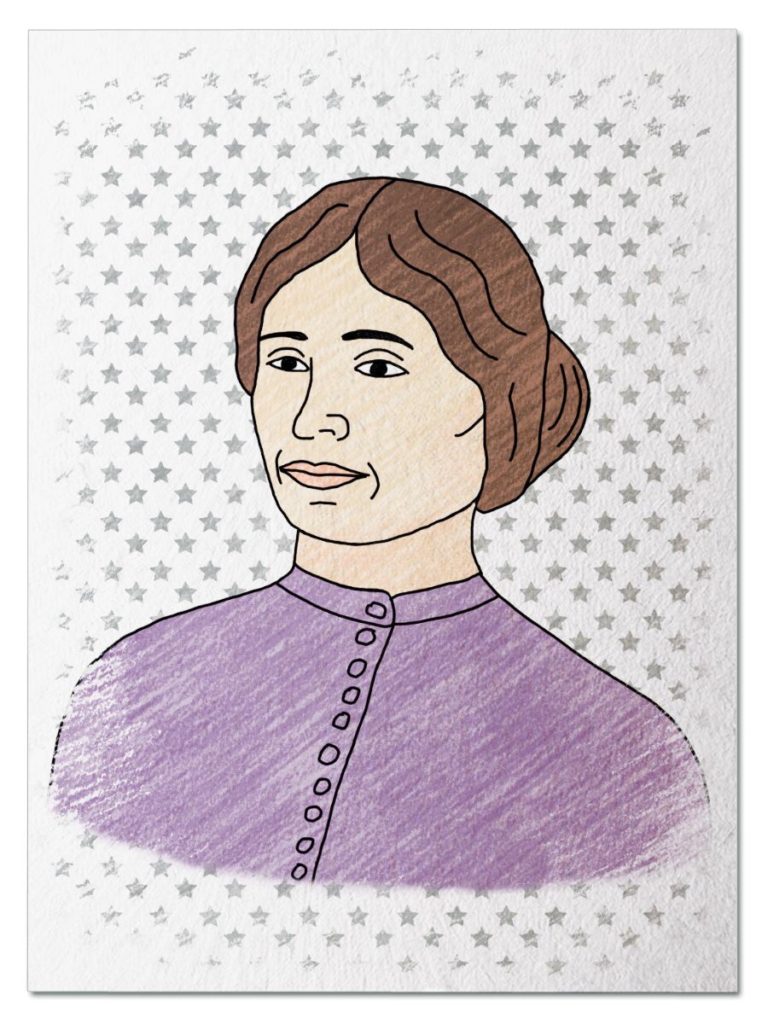
Culture Changer
An illness in infancy left her blind and deaf. She lived in a world of darkness and silence until her parents found a teacher who was able to pull her into the world of language. From there she became a star student, college graduate, and worldwide ambassador for disabled education. Travel back in time to 1937 New York and meet Helen Keller…
Her Ruby Shoe Moment
The Power of the Wand
Her Yellow Brick Road
Brains, Heart & Courage
Glinda’s Gallery
Just the Facts
Her Ruby Shoe Moment
Helen Keller couldn’t believe she was saying goodbye to the woman who had been her eyes and ears for the last 50 years. As she sat at Anne Sullivan’s deathbed, she wondered how she would carry on without her. Anne had been by her side, translating what she saw into Helen’s palm, since Helen was 6 years old.
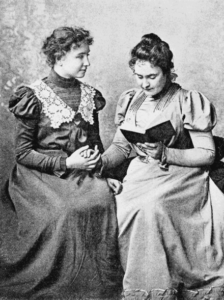
Anne reading to Helen in photograph taken by Alexander Graham Bell in 1899
It was Anne who had figured out how to connect a blind and deaf Helen to the world around her. It was Anne who had accompanied Helen to boarding school and college, translating lectures and assignments. Anne had been her faithful teacher, friend, and travel companion who made it possible for Helen to become an internationally known ambassador for the disabled. And now Helen knew from the vibrations of Anne’s breathing that the end was near. After Anne took her last breath, Helen felt her face and knew she was gone.
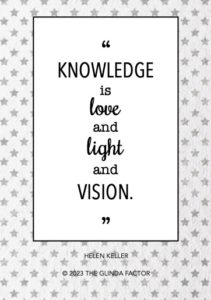 As Helen adjusted to life without Anne, she had a major decision to make. Months earlier, Takeo Iwahasi, the Director of the Nippon Lighthouse Welfare Center for the Blind in Japan, had visited Helen in New York. Takeo asked Helen to travel to Japan and help him lobby for special education. Japan had over 260,000 blind and/or deaf citizens, but only 4000 of them received any kind of schooling. Before she died, Anne encouraged Helen to say yes. Helen was apprehensive about going so far away from home without Anne, but decided to honor Anne’s memory and go. Helen’s secretary Polly Thomson agreed to accompany her.
As Helen adjusted to life without Anne, she had a major decision to make. Months earlier, Takeo Iwahasi, the Director of the Nippon Lighthouse Welfare Center for the Blind in Japan, had visited Helen in New York. Takeo asked Helen to travel to Japan and help him lobby for special education. Japan had over 260,000 blind and/or deaf citizens, but only 4000 of them received any kind of schooling. Before she died, Anne encouraged Helen to say yes. Helen was apprehensive about going so far away from home without Anne, but decided to honor Anne’s memory and go. Helen’s secretary Polly Thomson agreed to accompany her.
Their ship arrived in Yokohama Bay on April 15, 1937, where a large crowd had gathered to welcome them. The first few days of the trip did not calm Helen’s fears about traveling without Anne. On day 1, a pickpocket stole her address book and some money. On day 2, Helen wore a black dress to meet Emperor Hirohito at a cherry blossom festival, not knowing it was considered disrespectful.
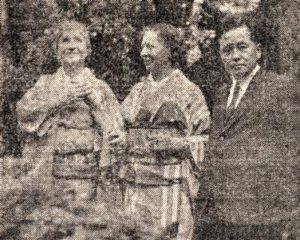
Helen, Polly, and Ishikawa Kazuo in Japan during her 1948 second trip (Shufu no Tomo)
Helen pressed on. She spent the next 10 weeks visiting 33 cities, speaking to more than 1 million people. Helen was a living example of how education could free people from their silent and dark worlds. The crowds, often a mix of disabled and able bodied, watched in amazement as Helen, Polly and Iwahashi demonstrated how Helen could communicate. Helen fingerspelled a sentence into Polly’s palm. Polly translated Helen’s words into spoken English, which Iwahashi translated into Japanese for the audience. Helen then “listened” to Polly through lip reading by putting her hands on Polly’s lips and face as Polly asked questions that Helen answered. Finally, Helen ended by speaking out loud the words “Love is power. Power is love. Let power and love build an independent and happy life for the physically handicapped. Let the light of sympathy brighten up the darkness of their lives.”
When Helen returned home in June 1937, she had made her mark on Japan. By November, the Japanese government announced plans for a new home for the blind.
The Power of the Wand
Helen visited more than 30 countries to lobby for education for the blind and deaf. She was a living example of how fully a disabled person could live when given the chance to learn and succeed.
Her Yellow Brick Road
When Anne Sullivan arrived at the Kellers’ Alabama home to meet her new student, blind and deaf 6 year old Helen, Helen was waiting on the front step. Helen was curious, started rummaging through Anne’s bag, and threw a furious tantrum when her mom stopped her. The next several days were a roller coaster. Helen knocked one of Anne’s teeth out and locked Anne in her bedroom and hid the key.
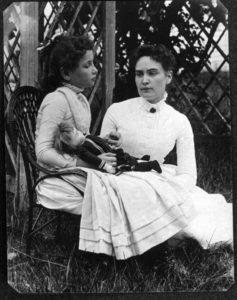
Helen with Anne in 1888 (New England Historic Genealogical Society)
There were moments when Helen was willing to sit quietly or walk with Anne in the gardens. Anne used that time to teach Helen the manual alphabet by spelling letters into Helen’s hand. Helen learned the letters but she didn’t understand that they were the building block of language. Anne spelled C-A-K-E each time she gave Helen cake, Helen didn’t grasp that Anne was teaching her the word cake, and it applied to the same treat each time. When Anne gave Helen her mug and spelled M-U-G, and then spelled W-A-T-E-R as Helen drank, Helen didn’t comprehend they were words for two different things.
Day after day, Anne spelled words into Helen’s hands and hoped for a breakthrough. One afternoon, she handed Helen a new doll and spelled D-O-L-L. Helen thought that D-O-L-L was the specific name for her special doll, and not a word that described every doll in the house. She knew this doll wasn’t hers, and angrily threw it onto the floor.
Anne took Helen by the hand and brought her outside to calm down. They walked to the well house to get a drink and wash their hands. Anne held one of Helen’s hands under the spout and she spelled W-A-T-E-R into her other hand over and over again. The continuous flow of the water was the catalyst Helen needed to understood what Anne was trying to tell her. This was water – just like the water in her mug – and it had a name. She lit up with the knowledge that everything had a name and spent the rest of the day learning the words for her family: father, mother, sister, teacher. For the next several months, Anne taught Helen the name of everything she touched.
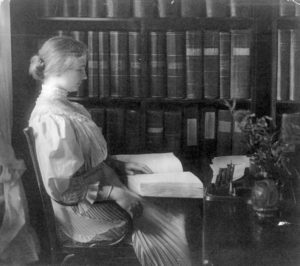
Helen reading braille in her study in 1907 (Wikimedia Commons)
Once Helen understood language, she learned to talk like hearing children do – by listening to the adults around her – with the difference that the adults spelled their conversation into her hand. More abstract concepts began to make sense. She learned the word “think” when she was having a difficult time stringing beads in a pattern. Anne touched Helen’s forehead while spelling T-H-I-N-K.
Helen soon was ready for new challenges. Anne taught her to read braille and brought her to a speech teacher to help her learn to speak. She learned the oral alphabet by holding her hand on the teacher’s tongue and lips as she said the alphabet. Helen then moved her mouth the same way and within an hour could say M, P, A, S, and T. After 11 lessons, Helen could put short sentences together that Anne and her speech teacher could understand.
As Helen reached her teens, Anne’s role shifted from teacher to interpreter and companion. They spent winters in Boston so Helen could attend the Perkins School for the Blind. Helen loved that her classmates knew the manual alphabet so could chat with her directly. They traveled to Grover Cleveland’s Inauguration, Niagara Falls, and the 1893 World’s Fair. Helen became very attuned to vibrations and smells, which made translating much easier for Anne.
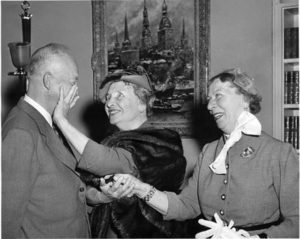
Helen reading lips while speaking with President Eisenhower. (USA public domain)
Helen moved to the Wright Humanson School for the Deaf in New York when she was 14. By then she was learning to read different languages, and took classes in French, Latin, and German. Her German instructor learned the manual alphabet and spoke German into Helen’s hand.
Helen wanted to go to Radcliffe College, which meant going to a “regular” prep school, with able bodied students. At 16, she moved to the Cambridge School for Young Ladies. They didn’t have built in infrastructure for Helen like her other schools did. In addition to translating lectures, Anne had to serve as an interpreter between Helen and her teachers., who didn’t know the manual alphabet. Helen also had to get her textbooks translated into braille.
The preliminary Radcliffe exams weren’t designed for the disabled either. The proctor spelled the questions to Helen. She spelled them back to confirm she understood and then wrote her answers with her braille typewriter. The proctor spelled her answers back to her so she could tell him what, if any, edits to make. This was much simpler when Helen took her final Radcliffe exams two years later. They translated the exam into braille for her so she could do it all by herself.
Helen entered Radcliffe in Fall 1900, with Anne at her side spelling lectures into her hand as fast as possible. She received her Bachelor of Arts in 1904, the first deaf/blind person to do so.
Brains, Heart & Courage
Helen’s first 19 months of life were completely ordinary. She lived with her parents in a small town in northwest Alabama. Helen was walking at a year and speaking words and short sentences by 18 months. Everything changed when she contracted an illness known as “brain fever.” She was not expected to survive, so when her fever finally broke, her parents were relieved even though she didn’t wake up for several days. But when Helen opened her eyes, her mom realized something was wrong. When she waved her hands across Helen’s face, her eyes didn’t blink. And when she spoke to her, Helen didn’t react. Helen was blind and deaf.
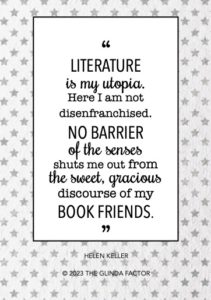 Helen’s parents were told to institutionalize her but they refused. Helen spent her days holding on to her mom’s skirts following her around and having huge temper tantrums. She smashed things, grabbed food from plates, overturned her baby sister’s cradle., and set her apron on fire in the kitchen.
Helen’s parents were told to institutionalize her but they refused. Helen spent her days holding on to her mom’s skirts following her around and having huge temper tantrums. She smashed things, grabbed food from plates, overturned her baby sister’s cradle., and set her apron on fire in the kitchen.
There were glimmers of the Helen she was before her illness. She had used gestures to communicate as a toddler and still used them now. She mimicked putting on glasses for her dad, put her hand on her face for her mom, and pretended to turn a crank and shiver when she wanted ice cream. When she helped fold clothes she knew which ones were hers. She responded to the vibrations of doors opening and closing.
As Helen grew, she became more aware of her limitations and her tantrums got more frequent and violent. Her mom, desperate for a solution, remembered an article (written by Charles Dickens!) she had read years earlier about a woman named Laura Bridgeman. Laura was a deaf and blind girl who lived in silence and darkness until Dr. Samuel Gridley Howe at the Perkins School for the Blind near Boston figured out how to reach her.
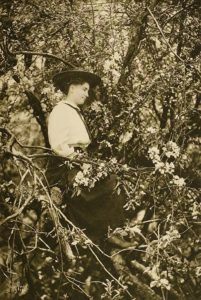
Helen in one of her favorite places – sitting in a “tree friend” in 1909 (Whitman)
The article inspired the Kellers to travel to the northeast. Their first stop was with a Baltimore doctor who confirmed that Helen’s disabilities were permanent, but believed she could be taught as Laura was. He referred them to Alexander Graham Bell, then a teacher at a school for the deaf in Washington DC. When they met Bell, he gave Helen his pocket watch and observed how she reacted to its vibrations. He too believed Helen could learn as Laura did, and sent them to Dr. Howe’s successor at Perkins, Michael Anagnos.
Anagnos examined Helen and agreed that a good teacher might be able to help. He selected 20 year old Anne Sullivan from a list of recent Perkins graduates. Anne had been partially blinded at age 5 by a virus, and then survived 4 years in a rat-infested poorhouse after her mother died. She escaped to Perkins when she was 14 by persuading a building inspector to help send her to school.
At Perkins, Anne met Laura Bridgeman and learned the manual alphabet to talk with her. When Anagnos asked her to move to Alabama to help Helen, Anne agreed it was a good fit. She returned to Perkins to review Laura’s files to prepare for her new challenge.
Glinda’s Gallery
Just the Facts
- Helen was born on June 27, 1880 in Tuscumbia, Alabama .
- Helen joined the American Foundation for the Blind in 1924.
- Helen won the Medal of Freedom in 1964
- Helen died on June 1, 1968. She was 88.
Want to Know More?
Keller, Helen; Macy, John Albert; Sullivan, Anne. The Story of My Life (Doubleday Page & Co. 1903)
Herrmann, Dorothy. Helen Keller A Life (The University of Chicago Press 1998)
Staff. “Helen Keller Biography” (American Foundation for the Blind)
Betts, Jennifer. “Helen Keller’s Family & Home Life: A Deeper Look” (Love to Know, Aug. 4, 2021)
